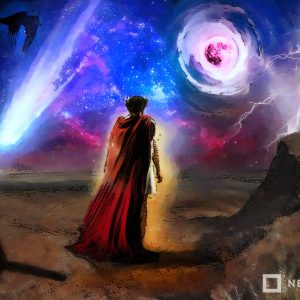China’s transformation to a Wolf Nation
In Text Messages this week, Jiang Rong could not have predicted how Xi Jinping would see the ways China could be aided by the sheep versus wolf theory in his popular autobiographical novel.
Author:
8 April 2021

China has always had problems with wolves. As in all farming societies, livestock in China endured centuries of predation by wolves and other fearsomely fanged creatures. The wolf was a bogey beast, instilling terror and revulsion quite out of proportion to its deeds.
On another continent, in Europe, the wolf was the symbol of darkness and evil, of nature red in tooth and claw, of a world beyond the human that was waiting to tear the throat out of any unwary human. Those attitudes went across the sea with the invaders and occupiers of “America”, and particularly of the northern continent so named. That the wolf was sacred to the nations that had lived there for centuries before the Mayflower threw its world-shattering anchor into the bay mattered not a jot to the farmers, hunters, trappers, prospectors and sundry others who bled ever westward.
Every Indigenous American society had council meetings at which the great standard question was “Who will speak for Wolf?” The wolf, increasingly, could not speak for itself as the European settlers shot it almost to extinction, a status above which it hovers precariously to this day.
Related article:
Back across the world, in the huge nation north of China, Mongolia, the wolf had more luck. Like their indigenous counterparts in North America, Mongolians revere the wolf. They acknowledge its vital role in conserving the ecosystem. Wolves will adjust their hunting according to the number of gazelle and other prey. In plentiful years, they will kill more, in lean years, fewer, thus ensuring the delicate balance between the grazing herds and the grazed fauna. They are, in short, the wardens of Mongolia’s grasslands and its ecology.
The contemporary wolf problem in China began in 2004 with a novel, Lang Tuteng by Jiang Rong, a political scientist retired from Beijing University. Few books before or since Mao Zedong’s Little Red Book have delivered such a profound shock to Chinese people and their psyche, society, culture and thinking. A decade and a half later, it is safe to say that the effect has been baleful, far from the robust optimism that the book first engendered in the heyday of its topping the bestseller lists in China.
Under the pseudonym of Jiang Rong, Lü Jiamin told an autobiographical tale of a young Chinese intellectual volunteering to join a work platoon in Chinese Inner Mongolia, a region in the northeast corner of China abutting Mongolia proper. He had done this in 1969, in enthusiastic response to Mao’s call for urban Chinese to venture “up to the mountains and down to the countryside”.
The young man who went to Inner Mongolia took to his task, unlike most of those who journeyed to this remote part of China. From the Mongolian nomads, he learnt much, and above all to respect the wolf. Almost 20 years later, in 1988, he began to write a fictionalised account of those days under the boundless blues skies and on the sweeping grasslands.
Sheep vs wolf
Published in 2004, Lang Tuteng (Wolf Totem) sold in the millions. But it was more than the story, set in a geographical otherworld and featuring a very different culture to China’s mix of ancient agrarian and modern urban, that appealed. It was the sheep versus wolf thesis that the author put forward.
Chinese, he claimed, were like sheep: clinging, timid, fearful, lacking all initiative and independence. Nomads were like wolves: hardy, brave, fearless, full of vigorous endeavour and self-sufficiency. Chinese needed to become more like or even just like wolves and shed the sheep’s skin that had constrained them for millennia.
Related article:
It was this revolutionary idea – by no means initially well received in the upper echelons of Chinese bureaucracy and intelligentsia – that appealed to millions of buyers and readers of the book. One of them, a rising member of the Chinese Communist Party, saw better than anyone else how China’s transformation to a Wolf Nation, a society taking the initiative and holding it, could be aided by the wolf theory or analogy. He was Xi Jinping, today the most powerful ruler that China has ever had, and with more might at his disposal than any but the greatest of T’ang and Ming dynasty emperors.
It is no surprise then that in the past few years China has been turning to what the Western media so catchily call “wolf warrior diplomacy”. This is a comprehensive repudiation of the quiet “soft diplomacy” that characterised China’s international dealings for the 1990s and the first decade of the 21st century. The wolf warrior stuff is difficult for Western – and other – nations to face. Discreet, retiring, mandarin-like behaviour has been replaced with diplomacy that is red in tooth and claw, ready to gouge detractors and launch lunging, pre-emptive attacks on the throats of rivals.
‘The Chinese are not the sheep’
Occasionally the wolf posture will embarrass its practitioners, as in the recent Twitter fiasco where a low-ranking diplomat resorted to one of Aesop’s 10 fables about wolves and sheep. Three-quarters of the way through, the poor time-server realised he was characterising the Chinese as innocent and thus by definition the sheep in the fracas, and not as the wolf or wolves as prescribed by his country’s new rules of diplomatic engagement.
“The Chinese are not the sheep,” he tweeted on in acute discomfort and quite possibly despair. Whether he will be sent to the Inner Mongolia Autonomous Region is an open question.
None of this can have been in the imagination of the author of Wolf Totem, which ends elegiacally, not triumphally. Here are its gut-wrenching final words, from the Howard Goldblatt translation.
“Standing alone by his window, Chen looked off to the north with a sense of desolation. The wolves had receded into legend, and the grassland was a distant memory. A nomadic herding society was now extinct; even the last trace left by the wolves of the Inner Mongolian grassland – the ancient cave of the wolf cub – would be buried in yellow sand.”


